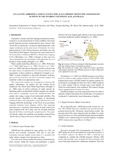Mostrar el registro sencillo del ítem
Evaluating airborne laser scanning for gully erosion detection and baseline mapping in the Fitzroy catchment, QLD, Australia
| dc.creator | Eustace, A.H. | es_ES |
| dc.creator | Witte, C. | es_ES |
| dc.creator | Carey, B.W. | es_ES |
| dc.date.accessioned | 2018-02-20T07:39:41Z | |
| dc.date.available | 2018-02-20T07:39:41Z | |
| dc.date.issued | 2007 | |
| dc.identifier.isbn | 978-84–9769-198-7 | |
| dc.identifier.uri | https://hdl.handle.net/2454/27381 | |
| dc.description | Resumen del trabajo presentado al IV International Symposium on Gully Erosion, celebrado en la Universidad Pública de Navarra del 17 al 19 de septiembre de 2007. | es_ES |
| dc.description.abstract | Australia’s climate and land management practises have resulted in an increased threat to land condition and water quality through sediment transported by gully erosion. The Fitzroy River catchment is located in Queensland and is the largest catchment on the east coast of Australia. It covers approximately 14.26 million hectares and drains into the Great Barrier Reef lagoon. Grazing is the major land use of the Fitzroy River catchment (80.93%), followed by cropping (6.2%) (Rowland et al., 2006). Changes to land use over time as population has increased in the region has led to a decline in water quality (Dougall et al., 2006). Water quality modelling (Prosser et al., 2001; Wilkinson et al., 2004; McKergow et al., 2005; Dougall et al., 2005; Joo et al., 2005;) has shown that gully erosion is likely to be the main source of sediment for the Fitzroy. However, the uncertainty in these models is substantial (Dougall et al., 2006). A major limitation is that gully densities, volumes, types and locations have not been accurately mapped and modelled to date at an appropriate scale. Two concurrent projects are in progress to improve the spatial information on gullies for the Fitzroy River catchment: The Short-Term Modelling Project (Dougall et al., 2006) aims to refine estimates of gully density by digitising gullies on Quickbird satellite imagery for sample areas and to extrapolate across the catchment from the sample sites using a range of environmental variables. The second project, described in this paper, is developing methods to detect and map gullies using Light Detection and Ranging (LIDAR) technology in the form of an aeroplane mounted Airborne Laser Scanner (ALS). The expected outcomes are (i) improved information on gully volume for areas sampled with ALS data; and (ii) accurate baseline datasets for future monitoring for sampled gullies. The paper will briefly outline the methods and products created from LIDAR derived Digital Elevation Models (DEM) to date. | en |
| dc.format.extent | 2 p. | |
| dc.format.mimetype | application/pdf | en |
| dc.language.iso | eng | en |
| dc.publisher | Universidad Pública de Navarra / Nafarroako Unibertsitate Publikoa | es |
| dc.relation.ispartof | Javier Casalí, Rafael Giménez (eds.): Progress in Gully Erosion Research. IV International Symposium on Gully Erosion. September 17-19, 2007. Pamplona, Spain. Pamplona: Universidad Pública de Navarra / Nafarroako Unibertsitate Publikoa, 2007 | es |
| dc.rights | © Autores; Universidad Pública de Navarra. Esta publicación no puede ser reproducida, almacenada o transmitida total o parcialmente, sea cual fuere el medio y el procedimiento, incluidas las fotocopias, sin permiso previo concedido por escrito por los titulares del copyright. | es_ES |
| dc.subject | Airborne laser scanning | en |
| dc.subject | Light Detection and Ranging (LIDAR) | en |
| dc.subject | Gully erosion detection | en |
| dc.title | Evaluating airborne laser scanning for gully erosion detection and baseline mapping in the Fitzroy catchment, QLD, Australia | en |
| dc.type | info:eu-repo/semantics/conferenceObject | en |
| dc.type | Contribución a congreso / Biltzarrerako ekarpena | es |
| dc.rights.accessRights | info:eu-repo/semantics/openAccess | en |
| dc.rights.accessRights | Acceso abierto / Sarbide irekia | es |
| dc.type.version | info:eu-repo/semantics/publishedVersion | en |
| dc.type.version | Versión publicada / Argitaratu den bertsioa | es |


